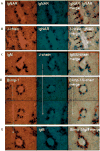Noncoordinate expression of J-chain and Blimp-1 define nurse shark plasma cell populations during ontogeny
- PMID: 23897025
- PMCID: PMC4046329
- DOI: 10.1002/eji.201343416
Noncoordinate expression of J-chain and Blimp-1 define nurse shark plasma cell populations during ontogeny
Abstract
B-lymphocyte-induced maturation protein 1 (Blimp-1) is the master regulator of plasma cell development, controlling genes such as those encoding J-chain and secretory Ig heavy chain. However, some mammalian plasma cells do not express J-chain, and mammalian B1 cells secrete "natural" IgM antibodies without upregulating Blimp-1. While these results have been controversial in mammalian systems, here we describe subsets of normally occurring Blimp-1(-) antibody-secreting cells in nurse sharks, found in lymphoid tissues at all ontogenic stages. Sharks naturally produce large amounts of both pentameric (classically "19S") and monomeric (classically "7S") IgM, the latter an indicator of adaptive immunity. Consistent with the mammalian paradigm, shark Blimp-1 is expressed in splenic 7S IgM-secreting cells, though rarely detected in the J-chain(+) cells producing 19S IgM. Although IgM transcript levels are lower in J-chain(+) cells, these cells nevertheless secrete 19S IgM in the absence of Blimp-1, as demonstrated by ELISPOT and metabolic labeling. Additionally, cells in the shark BM equivalent (epigonal) are Blimp-1(-). Our data suggest that, in sharks, 19S-secreting cells and other secreting memory B cells in the epigonal are maintained for long periods without Blimp-1, but like in mammals, Blimp-1 is required for terminating the B-cell program following an adaptive immune response in the spleen.
Keywords: B cells; Evolution; Immunoglobulins; Lymphoid organs; Transcription factors.
© 2013 WILEY-VCH Verlag GmbH & Co. KGaA, Weinheim.
Figures








References
-
- Coutinho A, Kazatchkine MD, Avrameas S. Natural autoantibodies. Curr Opin Immunol. 1995;7:812–818. - PubMed
-
- Thurnheer MC, Zuercher AW, Cebra JJ, Bos NA. B1 cells contribute to serum IgM, but not to intestinal IgA, production in gnotobiotic ig allotype chimeric mice. J Immunol. 2003;170:4564–4571. - PubMed
-
- Hardy RR. B-1 B cell development. J Immunol. 2006;177:2749–2754. - PubMed
Publication types
MeSH terms
Substances
Grants and funding
LinkOut - more resources
Full Text Sources
Other Literature Sources
Research Materials
Miscellaneous

